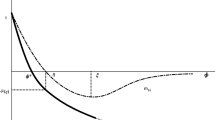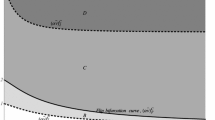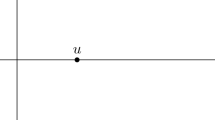Abstract
In a spatial competition model, we analyze the stability of the Nash-price equilibrium under horizontal and vertical product differentiation, considering both homogenous and heterogeneous expectations. Regardless of the nature of product differentiation, assuming that firms behave according to an adaptive expectations rule, it is found that the Nash-price equilibrium is asymptotically stable. If at least one firm follows the gradient rule based on marginal profit, an increase in the adjustment speed turns out to be a source of complexity. Moreover, the influence of the locations on price stability depends on the nature of product differentiation and on the expectations scheme.








Similar content being viewed by others
Notes
The second order conditions that ensure the existence of the maximum are the following: \( \frac{\partial^2{\prod}_1}{\partial {p_1}^2}=\frac{-1}{1-b-a}<0\kern0.5em \mathrm{and}\kern0.5em \frac{\partial^2{\prod}_2}{\partial {p_2}^2}=\frac{-1}{1-b-a}<0 \), for a ≥ 0, b ≥ 0 and a + b < 1.
The second order conditions for maximum are the following: \( \frac{\partial^2{\prod}_1}{\partial {p_1}^2}=\frac{-1}{b-a}<0\ \mathrm{and}\ \frac{\partial^2{\prod}_2}{\partial {p_2}^2}=\frac{-1}{b-a}<0 \) for b > a.
If a + b > 4, the Nash price equilibrium is given by: \( {p}_{1V}^{\ast }=\left(b-a\right)\left(b+a-2\right),{p}_{2V}^{\ast }=0 \). See Gabszewicz and Thisse (1986).
\( \left(0,0\right),\left(\frac{\left(1-b-a\right)\left(1-b+a\right)}{2},0\right)\ \mathrm{and}\ \left(0,\frac{\left(1-b-a\right)\left(1-b+a\right)}{2}\right) \) are unstable boundary equilibria of (14).
The Nash equilibrium never loses its stability through either a transcritical or a Neimark-Sacker bifurcation.
\( \left(0,0\right)\ \mathrm{and}\ \left(\frac{\left(b-a\right)\left(a+b\right)}{2},0\right) \) are two unstable boundary fixed points of (20).
If firm 1 is a gradient player and firm 2 is an adaptive player, the dynamic system will be \( {T}_H^{GA}:\left\{\begin{array}{l}{p}_{1,t+1}={p}_{1,t}+\alpha {p}_{1,t}\frac{p_{2,t}-2{p}_{1,t}+\left(1-b-a\right)\left(1-b+a\right)}{2\left(1-b-a\right)}\\ {}{p}_{2,t+1}={\theta}_2{p}_{2,t}+\left(1-{\theta}_2\right)\frac{p_{2,t}-2{p}_{1,t}+\left(1-b-a\right)\left(1-b+a\right)}{2\left(1-b-a\right)}\end{array}\right. \) being the equilibrium points \( {E}_H^{\ast } \) and the unstable boundary equilibrium\( \left(0,\frac{\left(1-b-a\right)\left(1+b-a\right)}{2}\right) \).
\( \left(\frac{\left(1-b-a\right)\left(1-b+a\right)}{2},0\right) \) is an unstable boundary fixed point of (24).
If firm 1 is a gradient player and firm 2 is an adaptive player, the dynamic system will be \( {T}_V^{GA}:\left\{\begin{array}{l}{p}_{1,t+1}={p}_{1,t}+\alpha {p}_{1,t}\frac{p_{2,t}-2{p}_{1,t}+\left(b+a\right)\left(b-a\right)}{2\left(b-a\right)}\\ {}{p}_{2,t+1}={\theta}_2{p}_{2,t}+\left(1-{\theta}_2\right)\frac{p_{2,t}-2{p}_{1,t}+\left(b+a\right)\left(b-a\right)}{2\left(b-a\right)}\end{array}\right. \)being the Nash equilibrium \( {E}_V^{\ast } \) the only steady state.
\( \left(\frac{\left(b-a\right)\left(b+a\right)}{2},0\right) \) is an unstable boundary fixed point of (28).
References
Agiza HN (1998) Explicit stability zones for Cournot games with 3 and 4 competitors. Chaos Soliton. Fract. 9:1955–1966
Agiza HN (1999) On the analysis of stability, bifurcation, chaos and chaos control of Kopel map. Chaos Soliton. Fract. 10:1909–1916
Agiza HN, Elsadany AA (2004) Chaotic dynamics in nonlinear duopoly game with heterogenous players. Appl Math Comput 149:843–860
Andaluz J, Jarne G (2016) Stability of vertically differentiated Cournot and Bertrand-type models when firms are boundedly rational. Ann Oper Res 238:1–25
Andaluz J, Elsadany AA, Jarne G (2017) Nonlinear Cournot and Bertrand-type dynamic triopoly with differentiated products and heterogeneous expectations. Math Comput Simulat 132:86–99
Askar SS (2014) On Cournot-Bertrand competition with differentiated products. Ann Oper Res 223:81–93
Bischi GI, Kopel M (2001) Equilibrium selection in a nonlinear duopoly game with adaptive expectations. J Econ Behav Organ 46:73–100
Bischi GI, Naimzada A (2000) Global analysis of a dynamic duopoly game with bounded rationalit. In: Filar JA, Gaitsgory V, Mizukami K (eds) Advances in Dynamic Games and Applications, vol 5, Birkhauser
Bischi GI, Chiarella C, Kopel M, Scidarovszky F (2010) Nonlinear oligopolies. Stability and bifurcations. Springer-Verlag, Berlin Heidelberg
Chamberlin E, 1933. The theory of monopolistic competition. Harvard University press. Cambridge (MA)
D’Aspremont C, Gabszewicz JJ, Thisse J-F (1979) On Hotelling’s stability in competition. Econometrica 47:1145–1150
Dixit AK (1986) Comparative statics for oligopoly. Int Econ Rev 27:107–122
Elsadany AA, Agiza HN, Elabbasy EM (2013) Complex dynamics and chaos control of heterogeneous quadropoly game. Appl Math Comput 219:11110–11118.
Fanti L, Gori L (2012) The dynamics of a differentiated duopoly with quantity competition. Econ Model 29:421–427
Fanti L, Gori L (2013) Stability analysis in a Bertrand duopoly with different product quality and heterogeneous expectations. J Ind Compet Trade 13:481–501
Fanti L, Gori L, Mammana C, Michetti E (2013) The dynamics of a Bertrand duopoly with differentiated products: synchronization, intermittency and global dynamics. J Chaos Soliton Fract 52:73–86
Fudenberg D, Tirole J (1984) The fat-cat effect, the puppy-dog ploy, and the lean and hungry look. Am Econ Rev 74(2):361–366
Gabszewicz J, Thisse J-F (1986) On the nature of competition with differentiated products. Econ J 96:160–172
Gandolfo G (2010) Economic dynamics. Forth. Springer, Heidelberg
Hotelling H (1929) Stability in competition. Econ J 39:41–57
Kopel M (1996) Simple and complex adjustment dynamics in Cournot duopoly models. Chaos Soliton. Fract. (12):2031–2048
Lewis M (2008) Price dispersion and competition with differentiated sellers. J Ind Econ 56(3):654–678
Liu Q, Zhang D (2013) Dynamic pricing competition with strategic costumers under vertical product differentiation. Manag Sci 59(1):84–101
Naimzada AK, Tramontana F (2012) Dynamic properties of a Cournot-Bertrand duopoly game with differentiated products. Econ Model 29(4):1436–1439
Puu T (1991) Chaos in duopoly pricing. Chaos Soliton Fract 1:573–581
Puu T (1998) The chaotic duopolists revisited. J Econ Behav Organ 33:385–394
Sandri M (1996) Numerical calculation of Lyapunov exponents. Math J 6(3):78–84
Tramontana F (2010) Heterogeneous duopoly with isoelastic demand function. Econ Model 27:350–357
Tremblay CH, Tremblay VJ (2011) The Cournot-Bertrand model and the degree of product differentiation. Econ Lett 111(3):233–235
Yu W, Yu Y (2014) The complexion of dynamic duopoly game with horizontal differentiated products. Econ Model 41:289–297
Zhang J, Da Q, Wang Y (2009) The dynamics of Bertrand model with bounded rationality. Chaos Soliton. Fract. 39:2048–2055
Funding
This study was funded by the Spanish Ministry of Economics and Competitiveness (ECO2016–74940-P) and the Government of Aragon and FEDER (S10/2016 and S13/2016 Consolidated Groups) and S40-17R Reference Group.
Author information
Authors and Affiliations
Corresponding author
Ethics declarations
This paper benefited from comments made by two anonymous referees of this journal.
Conflict of interest
The authors declare that they have no conflict of interest.
Rights and permissions
About this article
Cite this article
Andaluz, J., Jarne, G. On price stability and the nature of product differentiation. J Evol Econ 29, 741–762 (2019). https://doi.org/10.1007/s00191-018-0584-2
Published:
Issue Date:
DOI: https://doi.org/10.1007/s00191-018-0584-2
Keywords
- Horizontal product differentiation
- Vertical product differentiation
- Bounded rationality
- Dynamic stability




